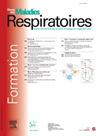Effects of perinatal exposure to nanoparticles on lung function
IF 0.5
4区 医学
Q4 RESPIRATORY SYSTEM
引用次数: 0
Abstract
Introduction
Nanoparticles (NP) are organic, inorganic, or composite materials with 3 dimensions between 1 and 100 nm. Due to their physico-chemical characteristics, which give them interesting properties, they can be found in many daily products. In particular, Titanium dioxide (TiO2) NP are widely used in industry in many applications (food additives, cosmetics, pigments, drugs etc.) due to their large range of properties (ultraviolet absorption, antimicrobial effect, food brightening and whitening agent etc.). This raises questions about their potential effect on health, particularly in the perinatal period, when the developing organism is more vulnerable to environmental stressors. Indeed, in mice models, TiO2NP administered to pregnant or lactating mice can reach the fetus, crossing the placental barrier via the bloodstream, or the offspring after translocation in the breastmilk. However, the long-term consequences of such exposure are still poorly studied. Our goal is to better understand the perinatal toxicity of TiO2NP on lung development and function, by studying two distinct TiO2NP with different sizes and crystalline phases.
Methods
Pregnant and/or lactating C57BL/6 J mice were exposed to 10 nm anatase (Ti10) and 21 nm anatase/rutile (P25) NP by non-surgical intra-tracheal instillation (100 μg of NP) once a week, during the 3 weeks of gestation and/or lactation. The pulmonary phenotype of the offspring was analyzed on juvenile mice (D23, 23 days after birth) and on adult mice (D60, 60 days after birth) with n = 8-12 per group. Mice were weighed every week from D9to D60. The pulmonary function was measured by two different techniques: whole-body plethysmography (VivoFlow®), a non-invasive technique on awake mice that measures respiratory times and the FlexiVent® system, an invasive technique on anesthetized mice that evaluates lung mechanical properties.
Results
Perinatal exposure to P25 induced a decrease in body weight for both males and females from D16until D60. Ti10 exposure induced a decrease in body weight for males from D32and a transient increase in females body weight from D16to D37. In juvenile mice, perinatal exposure to P25 and Ti10 NP induced abnormalities in respiratory parameters with no change in mechanical properties of the lung. Indeed, P25 gestational exposure induced a decrease of tidal volume (0.1873 ± 0.0178 ml n = 11 vs. 0.2120 ± 0.0332 n = 8) wheareas Ti10 gestational + postnatal exposure induced an increase of tidal volume (0.1472 ± 0.0169 ml n = 11 vs. 0.1255 ± 0.0082 n = 11). At the adult age, no difference in the pulmonary function was found in the Ti10 groups nor in the respiratory parameters in the P25 groups. On the other hand, regarding the mechanical properties of the lung, P25 gestational + postnatal exposure provoked male specific modifications characterized by a decrease of inspiratory capacity (0.7046 ± 0.0496 ml n = 5 vs. 0.8237 ± 0.0441 n = 4) and forced vital capacity (0.9850 ± 0.0836 ml n = 5 vs. 1.106 ± 0.0247 n = 4).
Conclusion
TiO2NP maternal exposure during the gestation and/or the lactation periods had an impact on the offspring, while this impact is different for the 2 NP tested with different sizes and crystalline phases. Ti10 exposure induced transient changes on the body weight and on the respiratory parameters that do not last until the adult age. On the other hand, P25 exposure provoked a permanent decrease in body weight, induced transient abnormalities of the respiratory parameters in juvenile mice and lung mechanical defects at the adult age. Further experiments will be needed to better characterize the defects observed and to explore the underlying mechanisms.
围产期接触纳米颗粒对肺功能的影响
纳米颗粒(NP)是有机、无机或复合材料,具有3个维度,在1到100纳米之间。由于它们的物理化学特性,赋予它们有趣的特性,它们可以在许多日常产品中找到。特别是二氧化钛(TiO2) NP,由于其广泛的性能(紫外线吸收、抗菌作用、食品增白剂等),在工业上广泛应用于许多应用领域(食品添加剂、化妆品、颜料、药品等)。这就提出了它们对健康的潜在影响的问题,特别是在围产期,这时发育中的生物体更容易受到环境压力的影响。事实上,在小鼠模型中,给孕鼠或哺乳期小鼠注射TiO2NP可以通过血液穿过胎盘屏障到达胎儿,或者在母乳中易位后到达后代。然而,对这种暴露的长期后果的研究仍然很少。我们的目的是通过研究两种不同大小和晶相的tio2 - np,更好地了解tio2 - np对肺发育和功能的围产期毒性。方法妊娠和(或)哺乳期C57BL/ 6j小鼠在妊娠和(或)哺乳期3周内,通过非手术气管内灌注10 nm锐钛矿(Ti10)和21 nm锐钛矿/金红石(P25) NP (100 μg),每周1次。对幼年小鼠(D23,出生后23天)和成年小鼠(D60,出生后60天)的后代肺表型进行分析,每组n = 8-12。从第9天至第60天,每周称重。通过两种不同的技术测量肺功能:全身体积脉搏描记仪(VivoFlow®),一种用于清醒小鼠的非侵入性技术,用于测量呼吸时间;以及FlexiVent®系统,一种用于麻醉小鼠的侵入性技术,用于评估肺力学特性。结果产前暴露于P25可导致小鼠体重从d16至D60下降。Ti10暴露导致雄鼠体重从d32开始下降,雌鼠体重从d16到D37短暂增加。在幼年小鼠中,围产期暴露于P25和Ti10 NP会导致呼吸参数异常,但肺的力学特性没有变化。的确,P25妊娠暴露诱导潮气量减少(0.1873±0.0178 ml n = 11 vs. 0.2120±0.0332 n = 8),而Ti10妊娠+产后暴露诱导潮气量增加(0.1472±0.0169 ml n = 11 vs. 0.1255±0.0082 n = 11)。在成年时,Ti10组的肺功能和P25组的呼吸参数均无差异。另一方面,在肺力学特性方面,P25妊娠期和产后暴露可引起男性特异性改变,其特征是吸气量(0.7046±0.0496 ml n = 5比0.8237±0.0441 n = 4)和强迫肺活量(0.9850±0.0836 ml n = 5比1.106±0.0247 n = 4)降低。结论妊娠期和/或哺乳期母体暴露于tio2 - np对子代有影响。而对于具有不同尺寸和晶相的2 NP测试,这种影响是不同的。Ti10暴露引起体重和呼吸参数的短暂变化,这种变化不会持续到成年。另一方面,暴露于P25可引起幼年小鼠体重的永久性下降,导致呼吸参数的一过性异常,并在成年时引起肺机械缺陷。需要进一步的实验来更好地描述观察到的缺陷并探索潜在的机制。
本文章由计算机程序翻译,如有差异,请以英文原文为准。
求助全文
约1分钟内获得全文
求助全文
来源期刊

Revue des maladies respiratoires
医学-呼吸系统
CiteScore
1.10
自引率
16.70%
发文量
168
审稿时长
4-8 weeks
期刊介绍:
La Revue des Maladies Respiratoires est l''organe officiel d''expression scientifique de la Société de Pneumologie de Langue Française (SPLF). Il s''agit d''un média professionnel francophone, à vocation internationale et accessible ici.
La Revue des Maladies Respiratoires est un outil de formation professionnelle post-universitaire pour l''ensemble de la communauté pneumologique francophone. Elle publie sur son site différentes variétés d''articles scientifiques concernant la Pneumologie :
- Editoriaux,
- Articles originaux,
- Revues générales,
- Articles de synthèses,
- Recommandations d''experts et textes de consensus,
- Séries thématiques,
- Cas cliniques,
- Articles « images et diagnostics »,
- Fiches techniques,
- Lettres à la rédaction.
 求助内容:
求助内容: 应助结果提醒方式:
应助结果提醒方式:


